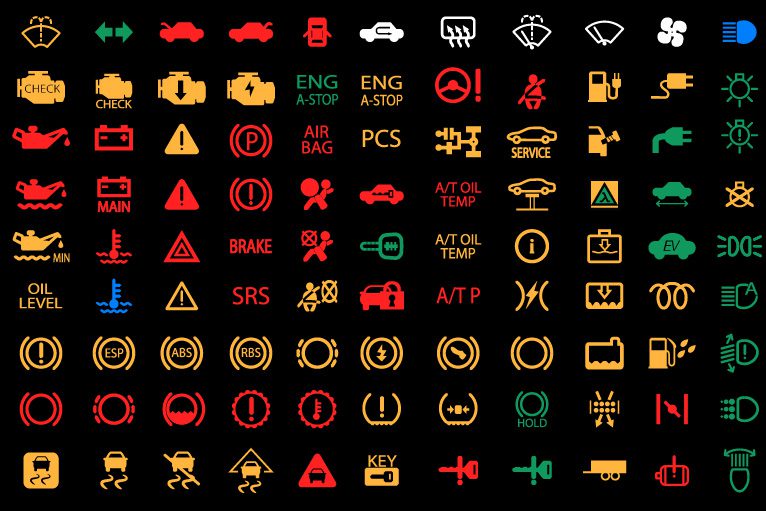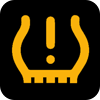
Demystify those dashboard lights
Dashboard lights and instrument displays have been around for decades. Over the years they’ve evolved just as much as cars themselves. Your car dashboard is no longer just a barrier to protect you from road debris. It’s an information hub that can tell you everything from your current oil levels to how many miles you can drive with the gas remaining in your tank.
In the earliest days, car dashboard instruments gave drivers only the most basic data – like fuel levels and coolant temperature. By the 1930s and 40s, those instruments included gauges and indicator lights, also known as idiot lights. They simply turned on or off without providing any additional information. Drivers needed basic knowledge of automotive mechanics to understand a red light for oil pressure was a warning to turn off the engine to prevent damage or an amber light meant the alternator wasn’t charging.
Dashboard Lights Today
Over the years, more instruments like speedometers, turn signal indicators, and high beam indicators were added to help drivers comply with traffic laws. Today’s vehicles allow drivers to have access to an overwhelming amount of information. Everything from average gas mileage to when to schedule maintenance is viewable from the driver’s seat. They can also make it confusing to know what exactly what to do when a warning light comes on.
The best way to understand the dashboard panel in your car is to refer to your vehicle’s owner’s manual. Inside, you’ll find a full rundown on the instruments and warning lights, along with brief information about what each indicates. Many times, vehicle dashboard lights won’t tell you exactly what went wrong. Instead, it will alert you that there’s an issue with your car that needs attention.
What does a dashboard light’s color mean?
There are generally three different grades of dash indicator, separated by color: Green or Blue, Yellow or Orange, and Red.
Green or blue dashboard lights are notification lights, telling you that a feature of your car is active. They don’t signal a fault or problem. Rather, they are an indication that these parts of your car are functioning exactly how you want them to function. Think your headlights, high beams, cruise control, or parking assistance system.
Yellow or orange dashboard lights are low-grade warning lights. There is a problem in your car that you should deal with in the very near future. Your car can usually still be driven a few miles, or the fix is one that can be easily taken care of, like closing your car door or pulling up to a gas station to fill your fuel tank.
Red dashboard lights are serious warning lights. You should stop immediately, or risk damage to the car. If you are out driving when you see a red warning light, pull over and call AAA if you need roadside assistance to move your car for service.
What do the more common dashboard lights actually mean?

Check Engine Light
One of the most common lights, but one of the most ambiguous. Sometimes it can be very minor, but if it’s flashing, be careful, because that could mean something serious. Either way, you should take your car to your local repair shop to get it checked out.

Oil Pressure Indicator Light
This dashboard light means you could be running low on oil, or something is wrong with your oil pump. Either way, you want to check your oil levels and get your car to a shop ASAP, as waiting could cause further issues with your engine leading to costly repairs.

Seat Belt Reminder
This light indicates that you need to buckle your seat belt. This is a simple reminder that is easy to fix, just buckle your seat belt. Just 36% of people killed in car crashes were wearing a seat belt. It’s easy to do and helps ensure you’re getting to your destination safely.

Engine Temperature Light
One of the most common in the summer, this light lets you know your engine’s temperature is too high. This is typically caused by a lack of coolant, but could be caused by other things. Check your coolant level, and keep a close eye on your cars engine temp to make sure you don’t do permanent damage.

Tire Pressure Warning Light
A more common light to see, the tire pressure warning light indicates that the pressure in one of your tires is too low or too high. Sometimes this is an immediate thing and you have a puncture, but more commonly just means a tire may be slowly leaking air and needs a check.

Battery Warning Light
This light means that somethings wrong with your car’s electrical system. It could be a bad battery or alternator, but could also be a loose wire. The good news is that AAA’s Battery Experts can help get you a new one and get you back on the road.

Low Fuel Warning Light
You’ve probably seen this light, and you’re never too happy to see it pop up, but the good news is that it’s one of the easiest to fix on this list! Did you know? If you run out of gas, AAA Oregon/Idaho members can get up to two gallons of gas to get you to your destination.

Brake Warning Light
The brake warning light usually means that the emergency brake is engaged. This is easily rectified by releasing it. If this does not solve the problem, then it’s likely a bigger issue with your primary brake system that you want to get fixed ASAP.
AAA is here to help!
If one of these lights comes on and you don’t feel safe driving, AAA is just a call away and we can get your car towed where you need it to be.
If one of those mysterious warning lights does come on in your car, you’ll probably need it serviced. To make that process easier, AAA has created the AAA Approved Auto Repair program. AAA Oregon/Idaho actively recruits repair shops in your area that are uniquely qualified to work on your vehicle. Only shops that demonstrate that they possess the equipment and the certified, trained technicians able to work on today’s high tech vehicles gain acceptance into the program. By holding these repair shops to the highest standards, we make sure that they earn our trust, so they’ll be able to gain yours.

